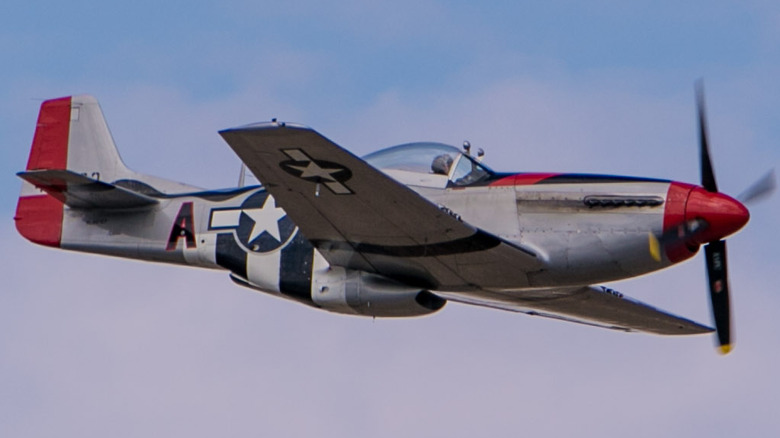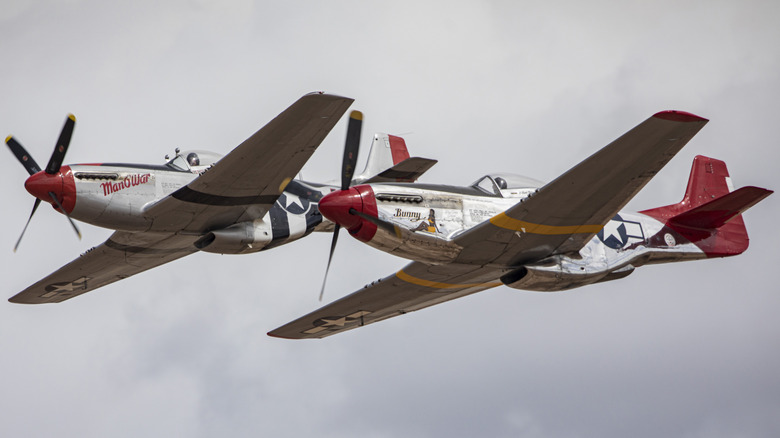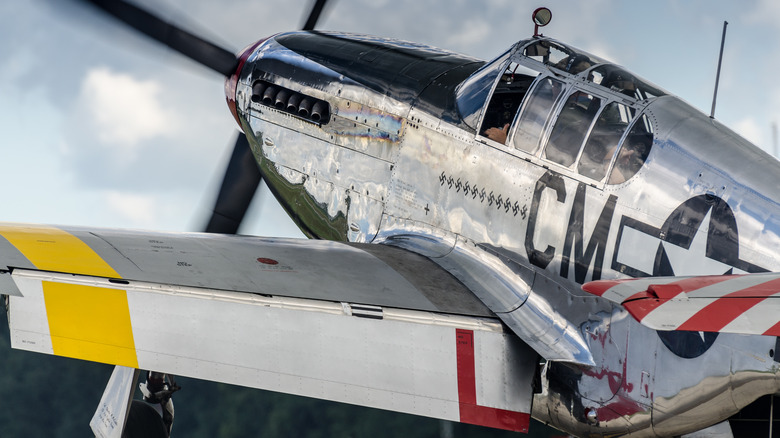The Biggest Strengths And Weaknesses Of America's P-51 Mustang
World War II saw all manner of iconic vehicles, from the U.S.-made Jeep to the British Churchill Tank. Aircraft were no different, as innovations pushed aviation engineering past prop planes and into jet aircraft, though this was toward the end of the conflict. One of the United States' most iconic fighters from WWII was the P-51 Mustang single-seat, long-range fighter and fighter-bomber. This workhorse aircraft dominated the skies throughout WWII and continued operating through much of the Korean War.
More than 15,000 P-51s were built between 1942 when they were first introduced for operation with the Royal Air Force, and 1957, when they were phased out in favor of jet fighters. These days, there are only about 150 airworthy P-51 Mustangs in existence, though they remain a popular attraction at air shows and museums. The P-51 came in multiple variants, depending on its intended use and the service operating it, and it was an effective air asset.
Throughout WWII, U.S. and Allied pilots claimed to have destroyed nearly 5,000 enemy aircraft while flying P-51s. It's estimated that Allied forces lost around 2,500 P-51s in combat, giving it almost a two-to-one kill ratio, which is impressive, to say the least. The P-51 was reliable, deadly, and versatile, but like any military vehicle rushed through design and production because of WWII, it had plenty of weaknesses to go with its many strengths.
The P-51 dominated throughout the theater of war
The P-51 didn't require much additional training to operate, which made it easier for Allied forces to fly. One of the key reasons the P-51 was such an effective fighter was its engine, the Rolls-Royce Merlin V-1650-7 (American planes used a licensed version produced by Packard). The supercharged 12-cylinder Merlin packed a punch with 1,695 hp, enabling the aircraft to hit a maximum true speed of 444 mph with an absolute ceiling of 41,200 feet.
The P-51 was fast and maneuverable, but that's not what made it deadly — that honor goes to the six .50 caliber machine guns packed onto the airframe. The P-51 could also be fitted with 10 5-inch rockets or 2,000 lbs of bombs when used for bombing runs — it could even drop its external fuel tanks as bombs. That wasn't its primary function, but the capability was there, and it was useful.
An estimated 275 pilots Aced (took down at least five enemy aircraft) while flying the P-51 — 19 in one day — which is a testament to its superior use in combat. Another strength was range, as it could fly 1,000 miles, which could stretch to 1,400 with external 85-gallon fuel tanks. The P-51 flew primarily for the Army, and while the Navy didn't use it, it could land on an aircraft carrier, though only 25 attempts were made before implementation, as forward operating bases (FOB) enabled deployment to Japan and elsewhere in the Pacific Theater.
The P-51 had some weaknesses toward the end of the war
One of the P-51's many claims to fame is the time it was used to shoot down a Mig-15 — a jet aircraft that far exceeded the P-51's speed. Retired Maj. John Yingling accomplished this during the Korean War, and he managed it with tracer rounds. While that's an achievement unlikely to be matched again, the P-51 did have several weaknesses that made it somewhat difficult to operate. Because it was a complex machine, it required a great deal of maintenance, which was expensive and time-consuming.
Other problems included its external fuel tanks, which were prone to catching fire, and the canopy initially had limited visibility compared to other fighters of the era. Another issue, which was typical of aircraft using liquid-cooled engines, was a slight yaw instability in the rudder. This could be compensated for, but was something pilots likely complained about or at least were aware of while operating the P-51.
Those are the main weaknesses that plagued the P-51 throughout its operation, but considering its record, they're minor concerns with reasonable workarounds that could be compensated for. Ultimately, the P-51 was one of the U.S. military's most successful fighter aircraft ever fielded in combat. To this day, it remains one of the most iconic aircraft used during World War II, having continuously demonstrated its combat effectiveness as it dominated the skies throughout the conflict.


